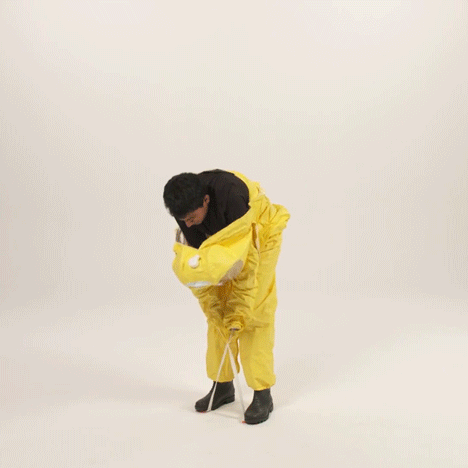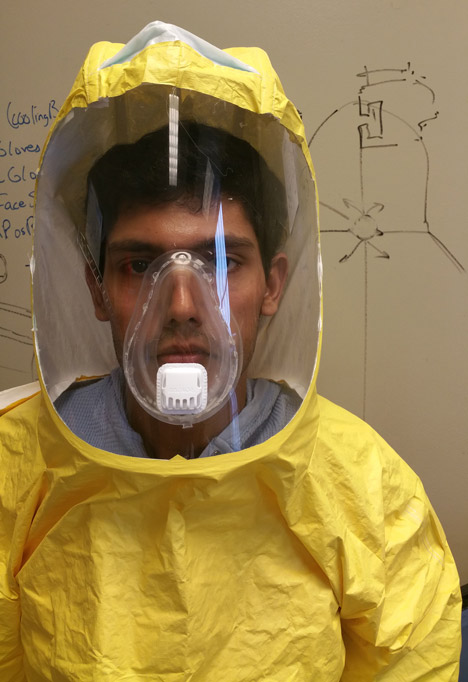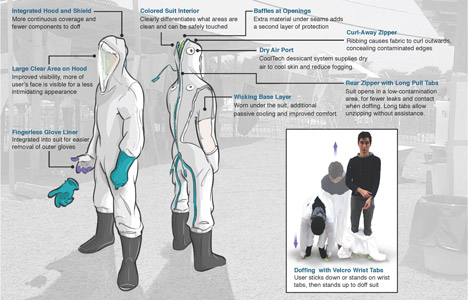Cocoon-like suit helps protect against Ebola by peeling away to minimise contact
A prototype protective suit for healthcare workers treating Ebola patients could lower the risk of transmission by peeling off without the wearer having to touch the outside (+ movie).
The PPE For Healthcare Workers suit was designed by a team from Johns Hopkins University, as part of a programme launched by the US Agency for International Development (USAID) to tackle challenges for people working in close proximity to Ebola patients.
The suit includes two breakaway tabs at the rear of the hood that are pulled apart to open the garment. Velcro strips attached to the arms are then placed underneath the feet, and as the wearer reassumes a standing position the outer layer peels away. By removing the clothing in this way, inner gloves stay fixed to the wearer while the outer gloves slip off easily.

Because Ebola is highly contagious through bodily fluids, health workers assisting Ebola patients run a high risk of infection and must wear protective gear. But standard issue Personal Protective Equipment (PPE) suits can be hard to take off without touching the outside, meaning the wearer risks infection if there are bacteria on the material.
The "cocoon-style doffing process" requires far fewer steps than existing garments, according to the design team.
Other improvements added to the design include a larger, clear visor in the hood accompanied by air vents, and a battery-powered dry air source that cools the wearer by blowing air into the hood.

Professor Youseph Yazdi, executive director of Johns Hopkins University's Center for Bioengineering Innovation and Design (CBID), told Dezeen that the design would "make doffing PPE faster, simpler, and safer".
The brief was to develop improvements that can be implemented quickly – meaning within a few months. "That eliminated the avenue of designing totally new materials for PPE," he said. "Our design therefore uses materials that are in use now for this purpose, such as DuPont Tychem."
To come up with the design, Johns Hopkins organised an all-university event to take place over a weekend, with the aim of bringing together the widest range of people and knowledge.
"People with experience and expertise in caring for patients with Ebola and other highly infectious diseases taught the group about the need for improvements in PPE, and demo'd their use," Yazdi explained.
"Then we followed our process over the next two days to subdivide the problem, form teams, generate concepts, make prototypes, and do some preliminary evaluations of these concepts in the presence of our field experts."

"We design through iterations of prototyping and testing, and in a few months will have a fully functioning 'works-like' prototype that will undergo field trials," Yazdi said. "For now, we have a mix of 'works-like' and 'looks-like' prototypes of the various elements of our overall design."
USAID will provide funding for the Johns Hopkins PPE suit and trials should begin in a few months.
"There are several large manufacturers of PPE in the market now, and several of them have expressed an interest in working with us to make a better PPE suit available quickly," Yazdi said, adding that getting agreements in place will be the biggest potential source of delay in bringing the design to market.
Other awardees of the USAID Grand Challenge are an antiseptic spray that kills bacteria on contact but remains effective for up to six hours by Aquarius GEP LLC and Innovative BioDefense, and a spray-on barrier that creates electro-static fields to kill and repel microbes on treated surfaces from SPR Advanced Technologies. The Personal Arterial Cooling Kit by Qore Performance is a modular system that cools the body through conduction at pulse points, without the need for attached power.